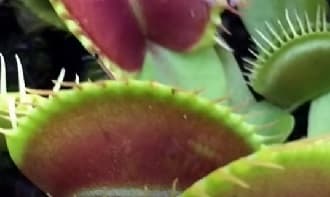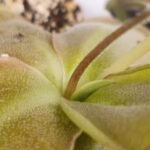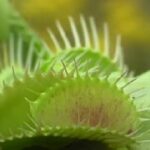As an Amazon Associate, this site earns commissions from qualifying purchases. For more details, click here.
Venus flytraps have a reputation for being hard to grow. One common complaint is the plant often turns black before dying quickly. But this doesn’t have to happen to your Venus flytrap, if you know the causes.
The most likely reasons why a Venus flytrap turns black are lack of sunlight, planted in the wrong soil, using tap water and being fed the wrong food or being fed too much.
There are a lot of possible causes true, but each one can be prevented. Let us look at these causes and what steps you can take to prevent it. If some leaves have already turned black, it’s still possible to save your Venus flytrap.
Water Problems
There are three issues: wrong water type, too much or too little water used.
Wrong water type used. It is very tempting to use tap water since it is right there at your fingertips. But there are reasons you should avoid this.
Use only bottled distilled water or rainwater for Venus flytraps. Reverse osmosis water is also acceptable.
Do not use tap water because it contains calcium, chlorine and other minerals that are harmful to plants. I personally use FIJI Natural Artesan Water because it is pure, ideal for all plants.
Too much or too little water. Watering Venus flytraps is challenging. It prefers moist soil, but it cannot be too damp either.
Instead of a spray bottle, use the tray method. Place the Venus flytrap on a tray and pour 1-2 inches of water. The hole in the pot will absorb the water, no need for spraying. Now you just need to replenish the tray with water when needed.
Wrong Soil Used
Venus flytraps only grow in nutrient-poor soil. The plant will perish if you use rich soil.
I use Perfect Plants Soil because it is ready to use out of the package. If you want a DIY approach, mix equal parts perlite and peat moss. Or you can add 5 parts peat moss, 2 parts perlite and 3 parts silica sand.
Do not add fertilizer to the soil because Venus flytraps get nutrients from insects. Using fertilized soil is one of the most common reasons why Venus flytraps turn black.
Not Enough Light
Venus flytraps should receive at least 6 hours of direct sunlight. The absolute minimum needed for survival is 2 hours, but it won’t thrive or produce many traps.
The more light Venus flytraps get, the brighter its colors. So if its traps and the plant in general has faded colors, it needs more light.
You can use indoor grow lights like Bestva if natural light is limited. Artificial lights are fine as long as they are on the plant for minimum 6 hours daily.
If some of the leaves are turning black or faded, relocate the pot so it gets more light. If your Venus flytrap turns red that is a good sign.
Incorrect Feeding
Venus flytraps cannot digest burgers, steak, bacon, cheese, raw meat or chocolate. This will not only turn the traps black but can also kill the plant.
The best food for Venus flytraps are flies, spiders and other small insects. Freeze dried mealworms from Soil Sunrise are a good source of nutrition too.
Too Much or Too Little Food
Venus flytraps get their energy through photosynthesis but insects provide nutrients.
Not enough food and the plant will suffer from lack of nutrients. But if you give it too much, the traps won’t be able to digest it. The trap loses energy in the process and starts losing its color too.
The solution depends on whether the Venus flytrap is indoors or outdoors.
- Outdoors: do not feed the plant. Its scent will lure insects and provide all the nutrients needed.
- Indoors: if your Venus flytrap is indoors, feed it freeze dried mealworms. It might catch a bug here and there, but it probably won’t be sufficient.
Venus flytraps usually take 7 days to digest a meal. If you see one of its traps closed, it means the plant is eating. Since Venus flytraps eat every 1-2 weeks, you should almost always see one trap closed.

Disease
Venus flytraps can get afflicted by Botrytis cinerea. You can tell the plant is infected because it has gray mold on its traps and leaves.
This usually happens when the plant gets too much water. The damp parts is where the mold appears and eventually spreads. This might cause the plant to blacken and the leaves to wilt.
You can prevent this by sitting the plant in a tray with 1-2 inches of water. It also helps to keep humidity at 50% or thereabouts.
Relocation
Do not move Venus flytraps around constantly. If you find a nice spot for it, keep the plant there.
Even if you don’t repot, moving a Venus flytrap from one location to another will require adjustment. It has to get used to the light, humidity, availability of prey, etc.
During this adjustment period, it’s normal for Venus flytraps to refuse to eat or look a bit weak. Give it a few weeks to be accustomed to the new location.
Stress
Plants get stressed due to poor conditions and Venus flytraps are no exception.
Any of the conditions described above – lack of light, too much or not enough water, lack of nutrients – any one or a combination of these will affect the plant.
Stressed Venus flytraps display various symptoms: wilted leaves, not eating, not growing traps, blackened leaves and faded colors.
If you let Venus flytraps flower and it doesn’t get enough energy and food, it could also weaken.
Flowering is a natural process, but it demands a lot of out Venus flytraps. When these plants bloom, there is less energy available to make traps. Not enough traps means fewer nutrients, which can stress the plant.
Dormancy
Blackening Venus flytraps are not always a bad sign. If the plant is is in dormancy, wilting and blackening are common.
Venus flytraps are dormant in winter and reemerge in spring. During this time it’s normal for the plant to wilt, for the leaves to drop and traps to die.
If this is your first time to grow a Venus flytrap, you might end up thinking the plant has died. But it is just dormant and will regrow in spring.
If your Venus flytrap looks sickly in late fall, do not worry. It is just getting ready for dormancy.
Natural Death for Traps
Each trap on a Venus flytrap can close 4-5 times. After that it will fall off and be replaced by another one.
It is normal for traps to turn black when it is dying. if the trap is several weeks old and starts to wilt, it is nothing to worry about.
There is nothing wrong with traps falling off as long as they are replaced by new ones. If your Venus flytrap is healthy, new traps will always replace fallen ones.
How to Prevent Venus Flytraps Turning Black
Nursing Venus flytraps that turned black is hard, so prevention is the key. Here are the main points.
- Provide 6 hours of direct sunlight
- Plant in nutrient-free soil (peat moss and perlite are ideal)
- Use only distilled, reverse osmosis or rainwater
- Keep humidity above 50%
- Suitable temperature range is 70-95 F (21-35 C)
Do not overfeed Venus flytraps. It’s fun to watch the plant trap and eat bugs, but the expends a lot of energy to do this.
The food should only be one-third the size of its trap. The trap will struggle with anything bigger, and you can tell because it starts to blacken.
Is It Safe to Remove Black Venus Flytrap Leaves?
Yes it is safe to remove them. Cut the black, dead traps with garden scissors but be careful not to snip off heathy ones.
Removal is optional however. Blackened leaves will fall off at some point eventually. If you have a lot of Venus flytraps, cutting each blackened trap won’t be practical.
There are ways to tell if the black leaves are normal or a sign there’s something wrong. Here are some general guidelines:
- If the traps are old and start to blacken, it’s likely near the end of its life cycle. This is normal.
- Your Venus flytrap starts to wilt and blacken in late fall or early winter. This is a sign the plant is about to go dormant. Nothing to worry about here.
- Sometimes a large bug might fall into one of the traps. The trap could die trying to eat its prey, but the rest of the plant will not be affected.
You can tell there is a problem if no new traps appear or the remaining leaves look pale. If your Venus flytrap looks sickly, it’s time to try one of the solutions given here.

My fascination with carnivorous plants began many, many years ago with Venus Fly Traps. Now I am more than happy to impart what I know with other enthusiasts and those who are curious about meat eating plants.


